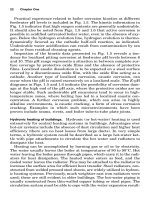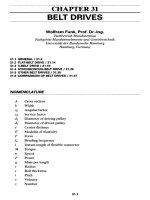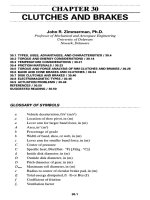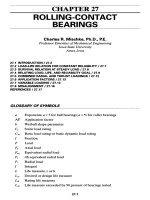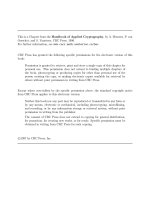Handbook of Global International Policy pdf
Bạn đang xem bản rút gọn của tài liệu. Xem và tải ngay bản đầy đủ của tài liệu tại đây (2.66 MB, 514 trang )
Handbook
of
Global
International
Policy
edited
by
Stuart
S.
Nagel
University
of
Illinois
Urbana,
Illinois
MARCEL
MARCEL
DEKKER,
INC.
NEW
YORK
•
BASEL
DEKKER
ISBN: 0-8247-0346-4
Headquarters
Marcel Dekker, Inc.
270 Madison Avenue, New York, NY 10016
tel: 212-696-9000; fax: 212-685-4540
Eastern Hemisphere Distribution
Marcel Dekker AG
Hutgasse 4, Postfach 812, CH-4001 Basel, Switzerland
tel: 41-61-261-8482; fax: 41-61-261-8896
World Wide Web
The publisher offers discounts on this book when ordered in bulk quantities. For more
information, write to Special Sales/Professional Marketing at the headquarters address
above.
Copyright 2000 by Marcel Dekker, Inc. All Rights Reserved.
Neither this book nor any part may be reproduced or transmitted in any form or by any
means, electronic or mechanical, including photocopying, microfilming, and recording,
or by any information storage and retrieval system, without permission in writing from
the publisher.
ISBN 0-203-50254-X Master e-book ISBN
(Print Edition)
This edition published in the Taylor & Francis e-Library, 2005.
“To purchase your own copy of this or any of Taylor & Francis or Routledge’s
collection of thousands of eBooks please go to www.eBookstore.tandf.co.uk.”
PUBLIC ADMINISTRATION AND PUBLIC POLICY
A Comprehensive Publication Program
Executive Editor
JACK RABIN
Professor of Public Administration and Public Policy
School of Public Affairs
The Capital College
The Pennsylvania State University—Harrisburg
Middletown, Pennsylvania
1.
Public Administration as a Developing Discipline
(in two parts), Robert T.
Golembiewski
2.
Comparative National Policies on Health Care
, Milton I. Roemer, M.D.
3.
Exclusionary Injustice: The Problem of Illegally Obtained Evidence
,Steven
R. Schlesinger
4.
Personnel Management in Government: Politics and Process
,JayM.
Shafritz, Walter L. Balk, Albert C. Hyde, and David H. Rosenbloom
5.
Organization Development in Public Administration
(in two parts), edited by
Robert T. Golembiewski and William B. Eddy
6.
Public Administration: A Comparative Perspective, Second Edition, Re-
vised and Expanded
, Ferrel Heady
7.
Approaches to Planned Change
(in two parts), Robert T. Golembiewski
8.
Program Evaluation at HEW
(in three parts), edited by James G. Abert
9.
The States and the Metropolis
, Patricia S. Florestano and Vincent L.
Marando
10.
Personnel Management in Government: Politics and Process, Second Edi-
tion, Revised and Expanded
, Jay M. Shafritz, Albert C. Hyde, and David H.
Rosenbloom
11.
Changing Bureaucracies: Understanding the Organization Before Selecting
the Approach
, William A. Medina
12.
Handbook on Public Budgeting and Financial Management
, edited by Jack
Rabin and Thomas D. Lynch
13.
Encyclopedia of Policy Studies
, edited by Stuart S. Nagel
14.
Public Administration and Law: Bench v. Bureau in the United States
,
David H. Rosenbloom
15.
Handbook on Public Personnel Administration and Labor Relations
, edited
by Jack Rabin, Thomas Vocino, W. Bartley Hildreth, and Gerald J. Miller
16.
Public Budgeting and Finance: Behavioral, Theoretical, and Technical Per-
spectives, Third Edition
, edited by Robert T. Golembiewski and Jack Rabin
17.
Organizational Behavior and Public Management
, Debra W. Stewart and
G. David Garson
18.
The Politics of Terrorism: Second Edition, Revised and Expanded,
edited
by Michael Stohl
19.
Handbook of Organization Management
, edited by William B. Eddy
20.
Organization Theory and Management
, edited by Thomas D. Lynch
21.
Labor Relations in the Public Sector
, Richard C. Kearney
22.
Politics and Administration: Woodrow Wilson and American Public Ad-
ministration
, edited by Jack Rabin and James S. Bowman
23.
Making and Managing Policy: Formulation, Analysis, Evaluation
, edited by
G. Ronald Gilbert
24.
Public Administration: A Comparative Perspective, Third Edition, Revised
,
Ferrel Heady
25.
Decision Making in the Public Sector
, edited by Lloyd G. Nigro
26.
Managing Administration
, edited by Jack Rabin, Samuel Humes, and Brian
S. Morgan
27.
Public Personnel Update
, edited by Michael Cohen and Robert T. Golem-
biewski
28.
State and Local Government Administration
, edited by Jack Rabin and Don
Dodd
29.
Public Administration: A Bibliographic Guide to the Literature
, Howard E.
McCurdy
30.
Personnel Management in Government: Politics and Process, Third
Edition, Revised and Expanded
, Jay M. Shafritz, Albert C. Hyde, and David
H. Rosenbloom
31.
Handbook of Information Resource Management
, edited by Jack Rabin
and Edward M. Jackowski
32.
Public Administration in Developed Democracies: A Comparative Study
,
edited by Donald C. Rowat
33.
The Politics of Terrorism: Third Edition, Revised and Expanded
, edited by
Michael Stohl
34.
Handbook on Human Services Administration
, edited by Jack Rabin and
Marcia B. Steinhauer
35.
Handbook of Public Administration
, edited by Jack Rabin, W. Bartley
Hildreth, and Gerald J. Miller
36.
Ethics for Bureaucrats: An Essay on Law and Values, Second Edition,
Revised and Expanded
, John A. Rohr
37.
The Guide to the Foundations of Public Administration
, Daniel W. Martin
38.
Handbook of Strategic Management
, edited by Jack Rabin, Gerald J.
Miller, and W. Bartley Hildreth
39.
Terrorism and Emergency Management: Policy and Administration,
William
L. Waugh, Jr.
40.
Organizational Behavior and Public Management: Second Edition, Revised
and Expanded
, Michael L. Vasu, Debra W. Stewart, and G. David Garson
41.
Handbook of Comparative and Development Public Administration
, edited
by Ali Farazmand
42.
Public Administration: A Comparative Perspective, Fourth Edition
, Ferrel
Heady
43.
Government Financial Management Theory
, Gerald J. M iller
44.
Personnel Management in Government: Politics and Process, Fourth
Edition, Revised and Expanded
, Jay M. Shafritz, Norma M. Riccucci, David
H. Rosenbloom, and Albert C. Hyde
45.
Public Productivity Handbook
, edited by Marc Holzer
46.
Handbook of Public Budgeting
, edited by Jack Rabin
47.
Labor Relations in the Public Sector: Second Edition, Revised and Ex-
panded
, Richard C. Kearney
48.
Handbook of Organizational Consultation
, edited by Robert T. Golem-
biewski
49.
Handbook of Court Administration and Management
, edited by Steven W.
Hays and Cole Blease Graham, Jr.
50.
Handbook of Comparative Public Budgeting and Financial Management
,
edited by Thomas D. Lynch and Lawrence L. Martin
51.
Handbook of Organizational Behavior
, edited by Robert T. Golembiewski
52.
Handbook of Administrative Ethics,
edited by Terry L. Cooper
53.
Encyclopedia of Policy S tudies: Second Edition, Revised and Expanded,
edited by Stuart S. Nagel
54.
Handbook of Regulation and Administrative Law,
edited by David H.
Rosenbloom and Richard D. Schwartz
55.
Handbook of Bureaucracy,
edited by Ali Farazmand
56.
Handbook of Public Sector Labor Relations
, edited by Jack Rabin, Thomas
Vocino, W. Bartley Hildreth, and Gerald J. Miller
57.
Practical Public Management
, Robert T. Golembiewski
58.
Handbook of Public Personnel Administration
, edited by Jack Rabin,
Thomas Vocino, W. Bartley Hildreth, and Gerald J. Miller
59.
Public Administration: A Comparative Perspective, Fifth Edition
, Ferrel
Heady
60.
Handbook of Debt Management
, edited by Gerald J. Miller
61.
Public Administration and Law: Second Edition
, David H. Rosenbloom and
Rosemary O’Leary
62.
Handbook of Local Government Administration
, edited by John J. Gargan
63.
Handbook of Administrative Communication
, edited by James L. Garnett
and Alexander Kouzmin
64.
Public Budgeting and Finance: Fourth Edition, Revised and Expanded
,
edited by Robert T. Golembiewski and Jack Rabin
65.
Handbook of Public Administration: Second Edition
, edited by Jack Rabin,
W. Bartley Hildreth, and Gerald J. Miller
66.
Handbook of Organization Theory and Management: The Philosophical
Approach
, edited by Thomas D. Lynch and Todd J. Dicker
67.
Handbook of Public Finance
, edited by Fred Thompson and Mark T. Green
68.
Organizational Behavior and Public Management: Third Edition, Revised
and Expanded
, Michael L. Vasu, Debra W. Stewart, and G. David Garson
69.
Handbook of Economic Development
, edited by Kuotsai Tom Liou
70.
Handbook of Health Administration and Policy
, edited by Anne Osborne
Kilpatrick and James A. Johnson
71.
Handbook of Research Methods in Public Administration
, edited by Gerald
J. Miller and Marcia L. Whicker
72.
Handbook on Taxation
, edited by W. Bartley Hildreth and James A.
Richardson
73
. Handbook of Comparative Public Administration in the Asia-Pacific Basin
,
edited by Hoi-kwok Wong and Hon S. Chan
74
. Handbook of Global Environmental Policy and Administration,
edited by
Dennis L. Soden and Brent S. Steel
75
. Handbook of State Government Administration
, edited by John J. Gargan
76.
Handbook of Global Legal Policy
, edited by Stuart S. Nagel
77.
Handbook of Public Information Systems
, edited by G. David Garson
78
. Handbook of Global Economic Policy
, edited by Stuart S. Nagel
79.
Handbook of Strategic Management: Second Edition
,
Revised and Ex-
panded,
edited by Jack Rabin, Gerald J. Miller, and W. Bartley Hildreth
80.
Handbook of Global International Policy,
edited by Stuart S. Nagel
81.
Handbook of Organizational Consultation: Second Edition
,
Revised and
Expanded
, edited by Robert T. Golembiewski
82.
Handbook of Global Political Policy
, edited by Stuart S. Nagel
83.
Handbook of Global Technology Policy
, edited by Stuart S. Nagel
84.
Handbook of Criminal Justice Administration
, edited by Toni DuPont-
Morales, Michael K. Hooper, and Judy H. Schmidt
85.
Labor Relations in the Public Sector: T hird Edition
, edited by Richard C.
Kearney
86.
Handbook of Administrative Ethics: Second Edition
,
Revised and
Expanded
, edited by Terry L. Cooper
87.
Handbook of Organizational Behavior: Second Edition
,
Revised and Ex-
panded
, edited by Robert T. Golembiewski
88.
Handbook of Global Social Policy
, edited by Stuart S. Nagel and Amy
Robb
89.
Public Administration: A Comparative Perspective
,
Sixth Edition
, Ferrel
Heady
90.
Handbook of Public Quality Management
, edited by Ronald J. Stupak and
Peter M. Leitner
91.
Handbook of Public Management Practice and Reform
, edited by Kuotsai
Tom Liou
92.
Personnel Management in Government: Politics and Process
,
Fifth Edition
,
Jay M. Shafritz, Norma M. Riccucci, David H. Rosenbloom, Katherine C.
Naff, and Albert C. Hyde
93.
Handbook of Crisis and Emergency Management
, edited by Ali Farazmand
94.
Handbook of Comparative and Development Public Administration: Second
Edition, Revised and Expanded
, edited by Ali Farazmand
95.
Financial Planning and Management in Public Organizations
,AlanWalter
Steiss and ‘Emeka O. Cyprian Nwagwu
96.
Handbook of International Health Care Systems
, edited by Khi V. Thai,
Edward T. Wimberley, and Sharon M. McManus
97.
Handbook of Monetary Policy
, edited by Jack Rabin and Glenn L. Stevens
98.
Handbook of Fiscal Policy
, edited by Jack Rabin and Glenn L. Stevens
99.
Public Administration: An Interdisciplinary Critical Analysis
, edited by Eran
Vigoda
100.
Ironies in Organizational Development: Second Edition
,
Revised and Ex-
panded
, edited by Robert T. Golembiewski
101.
Science and Technology of Terrorism and Counterterrorism
, edited by
Tushar K. Ghosh, Mark A. Prelas, Dabir S. Viswanath, and Sudarshan K.
Loyalka
102.
Strategic Management for Public and Nonprofit Organizations
,AlanWalter
Steiss
103.
Case Studies in Public Budgeting and Financial Management: Second
Edition, Revised and Expanded
, edited by Aman Khan and W. Bartley
Hildreth
Additional Volumes in Preparation
Principles and Practices of Public Administration
, edited by Jack Rabin,
Robert F. Munzenrider, and Sherrie M. Bartell
Handbook of Developmental Policy Studies
, edited by Stuart S. Nagel
Handbook of Conflict Management
, edited by William J. Pammer, Jr., and
Jerri Killian
Annals of Public Administration
1.
Public Administration: History and Theory in Contemporary Perspective
,
edited by Joseph A. Uveges, Jr.
2.
Public Administration Education in Transition
, edited by Thomas Vocino
and Richard Heimovics
3.
Centenary Issues of the Pendleton Act of 1883
, edited by David H. Ro-
senbloom with the assistance of Mark A. Emmert
4.
Intergovernmental Relations in the 1980s
, edited by Richard H. Leach
5.
Criminal Justice Administration: Linking Practice and Research
, edited by
William A. Jones, Jr.
To the people who stimulated
my awareness of international policy, including:
Harold Guetzkow, Ernst Haas, Charles Lerche,
Frank Magruder, Frederick Schuman, and Quincy Wright.
Preface
This handbook on global international policy is one in a set of six global policy
handbooks. The other five deal with economic, technology, social, political, and
legal policy.
Public policy studies in the past have tended to emphasize domestic policy
rather than cross-national policy. This has been especially true of American pol-
icy studies, which tend to be especially nation-bound. This is also true, to some
extent, of policy studies in France, Russia, China, Brazil, and elsewhere.
When American policy studies show an interest in other countries, these
other countries tend to be exclusively Western European countries. This six-
volume set, however, will include all the regions of the world, consisting of Af-
rica, Asia, Eastern Europe, Latin America, North America, and Western Europe.
Public policy studies also tend to place a lot of emphasis on methods of
analysis and the policy process. They do not get much into substance, especially
at the professional or scholarly level, as contrasted to undergraduate textbooks.
That is so because scholars have traditionally considered substance to be not as
philosophical or theoretical as methods or processes.
In this six-volume set, however, each volume is devoted to a different sub-
stantive field, including economic, technology, social, political, international, and
legal policy. The discussions are more theoretical than most substantive discus-
sions because they emphasize comparisons across places, across times, and across
different substantive fields. Furthermore, the discussions are practical in terms
of applicability to real-world problems.
Scholars and others who study comparative government unfortunately tend
to overemphasize structures like federalism, separation of powers, legislatures,
v
vi Preface
chief executives, and supreme courts while neglecting public policy, which this
series emphasizes.
Comparative government scholars also tend to emphasize area studies
which involve specialization in a single country or subregion, as contrasted to
this set of six volumes which cuts across six regions and six policy fields.
Thus the key objective of this set is to encourage more cross-national and
cross-policy research and applications. The set not only advocates more of this
kind of research but practices what it advocates by providing almost 200 studies
in six volumes which average about 30 studies per volume. This should be a
landmark set in the disciplines of both public policy studies and cross-national
studies.
Stuart S. Nagel
Contents
Preface v
Contributors xi
1. International Policy: An Introduction 1
Stuart S. Nagel
2. What Price Empire? A Study of Costs and Benefits of American
Involvement in Zaire During the Mobutu Era 21
John F. Clark
3. The Conflict in Eritrea Reconsidered 43
Seifudein Adem
4. Spanish Enclaves in North Africa 57
Heriberto Cairo
5. A Problem-Centered Approach for Understanding Foreign
Policy: Some Examples from U.S. Foreign Policy Toward
Southern Africa 79
Helen E. Purkitt
vii
viii Contents
6. Beginning and Ending the Cold War in East Asia 103
Gavan McCormack
7. Increasing the Strategic Compatibility of the ROK and DPRK 119
Laure Paquette
8. Defense by Other Means: Australia’s Arms Control and
Disarmament Diplomacy 143
Ramesh Thakur
9. A Palestinian State: Evaluating the Risks 165
Efraim Inbar
10. Nationalism Against Lost Legitimacy: Slovenes Versus the
Yugoslav Military 185
Ljubica Jelus
ˇ
ic
˘
11. Russian Peacekeeping 203
Joseph L. Nogee
12. From the Brezhnev Doctrine to Partnership: The New
International Relations of Eastern Europe 229
Gregory O. Hall
13. Civil-Military Relations from Westphalia to the European
Union 251
Glen Segell
14. The European Public and Post–Cold War Security Policy 287
Andrew H. Ziegler, Jr.
15. National Culture or International Trade? The Labour
Government’s Media Policies 311
Des Freedman
16. International Integration/Subnational Conflict: The Zapatistas
and International Relations 335
J. Donovan Malley
17. Wars and the Military: Civil Instruments for Politics in
Colombia 359
Adolfo Leo
´
n Atehortu
´
a Cruz
Contents ix
18. Elite Images and Post–Cold War Foreign Policy Decision-
Making: The United States in Haiti 367
Dorcas Eva McCoy
19. Emerging Trends in International Security: American Foreign
Policy Options 387
Robert H. Puckett
20. U.S. Foreign Exchange Interventions: Domestic Politics and
International Factors 393
Quan Li
21. Security Policy at the Dawn of the Nuclear Age: The Case of
the Aircraft Nuclear Propulsion Project 417
Carolyn C. James
22. Expanding the Existing Nuclear Disarmament Regime:
Prospects for Bilateral U.S.–Russian Cooperation 439
George A. MacLean
23. Economic Development and International Transportation Along
the Border: Exploring Feasibility Issues for State and Local
Governments 463
Nadia Rubaii-Barrett and William A. Taggart
Index 483
Contributors
Seifudein Adem Institute of Social Sciences, University of Tsukuba, Ibaraki,
Japan
Heriberto Cairo Facultad de Ciencias Polı
´
ticas y Sociologı
´
a, Universidad
Complutense de Madrid, Madrid, Spain
John F. Clark Department of International Relations, Florida International
University, Miami, Florida
Adolfo Leo
´
n Atehortu
´
a Cruz Estudios Juridicos, Universidad del Valle, Cali,
Colombia
Des Freedman School of Social Sciences, University of North London, Lon-
don, England
Gregory O. Hall Department of Political Science, St. Mary’s College of Mary-
land, St. Mary’s City, Maryland
Efraim Inbar Department of Political Science, Bar-Ilan University, Ramat
Gan, Israel
Carolyn C. James International Institute of Theoretical and Applied Physics,
Iowa State University, Ames, Iowa
xi
xii Contributors
Ljubica Jelus
ˇ
ic
˘
Defence Studies Division, Department of Political Sciences,
Faculty of Social Sciences, University of Ljubljana, Ljubljana, Slovenia
Quan Li Department of Political Science, Pennsylvania State University, Uni-
versity Park, Pennsylvania
George A. MacLean Department of Political Studies, University of Manitoba,
Winnipeg, Manitoba, Canada
J. Donovan Malley Department of Political Science, University of Wisconsin–
Madison, Madison, Wisconsin
Gavan McCormack Research School of Pacific and Asian Studies, Australian
National University, Canberra, Australia
Dorcas Eva McCoy Department of Political Science, University of Central
Florida, Orlando, Florida
Stuart S. Nagel Department of Political Science, University of Illinois, Urbana,
Illinois
Joseph L. Nogee Department of Political Science, University of Houston,
Houston, Texas
Laure Paquette Department of Political Science, Lakehead University, Thun-
der Bay, Ontario, Canada
Robert H. Puckett Department of Political Science, Indiana State University,
Terre Haute, Indiana
Helen E. Purkitt Political Science Department, United States Naval Academy,
Annapolis, Maryland
Nadia Rubaii-Barrett Department of Government, New Mexico State Univer-
sity, Las Cruces, New Mexico
Glen Segell Institute of Security Policy, London, England
William A. Taggart Department of Government, New Mexico State Univer-
sity, Las Cruces, New Mexico
Contributors xiii
Ramesh Thakur Department of Peace and Governance, United Nations Uni-
versity, Tokyo, Japan
Andrew H. Ziegler, Jr. Department of Political Science, Methodist College,
Fayetteville, North Carolina
1
International Policy
An Introduction
Stuart S. Nagel
University of Illinois, Urbana, Illinois
Win-win or super-optimizing analysis of public policy problems tries to find fea-
sible solutions which can enable conservatives, liberals, and other major view-
points to come out ahead of their best initial expectations simultaneously. The
elements in the analysis include (1) conservative goals and alternatives, (2) liberal
goals and alternatives, (3) relations between the major alternatives and goals, (4)
the development of win-win solutions, and (5) feasibility hurdles to overcome.
The feasibility hurdles to be overcome include economic, administrative, politi-
cal, psychological, legal, international, and technological hurdles, also the disrup-
tion of displaced firms and individuals.
As applied to international policy we are referring to (1) international com-
petitiveness, (2) tariff reduction, (3) making provisions for workers displaced as
a result of tariff reduction, (4) immigration policy, (5) international refugees, (6)
volunteerism in technical assistance, (7) foreign factories in the United States,
(8) U.S. factories going abroad, (9) dollar exchange rates, (10) international eco-
nomic communities, and (11) exporting democracy in making foreign policy deci-
sions.
1
1
2 Nagel
I. INTERNATIONAL POLICY: THE U.S. AND THE UNITED
NATIONS
A. Conservative and Liberal Positions
The key conservative goal in this context, relating to the role of the United States
in helping the United Nations to bring peace to Bosnia, is to save U.S. dollars
and save lives. The conservatives weren’t always so oriented toward isolation.
They were very interventionist back in the days of the cold war, especially in
regard to curtailing the expansion of the Soviet Union. But at the present time,
they do espouse more of an isolationist, less of an intervention, policy than liber-
als do. The conservative alternative for saving U.S. dollars and lives is to keep
U.S. troops at home. They feel it’s more important to develop the United States
first. The liberals, on the other hand, are more oriented toward being the police-
men of the world traveling around with the goal of promoting world peace (Table
1). More idealistic or maybe more naive, they believe in what is sometimes re-
ferred to as a social worker ideology, which necessitates intervention.
B. Win-Win Solution
The win-win solution saves U.S. dollars, U.S. lives, and promotes world peace
simultaneously. An approach recommended by some who specialize in interna-
tional relations is the use of a volunteer UN force. This would result in American
troops never being sent to Bosnia, Somalia, or anywhere else. The United Nations
Table 1 The U.S. and UN Peacekeeping
Criteria
Liberal:
Conservative: Promote peace,
Saving U.S. prosperity, and
Alternatives dollars and lives democracy
Conservative:
Isolationism, minimum U.S. involvement ϩϪ
Liberal:
Interventionism, substantial U.S. in- Ϫϩ
volvement
Neutral:
In between 0 0
SOS:
Volunteer UN force ϩϩ ϩϩ
International Policy: An Introduction 3
would have its own volunteer force, a force similar to the French Foreign Legion.
It would consist of people from all over the world who would join partly out of
idealism, partly because it pays some money. They would not be allowed to join
unless they had some military experience of some kind, indicating an aptitude
for military training. It would provide an opportunity for Vietnam War veterans,
Russian soldiers who had fought in Afghanistan, and others to participate in a
force which would be devoted to a righteous cause. The officers would be officers
who had served in the militaries of their various countries.
As a result there would be no American soldiers in this UN force. While
Americans may join the UN force, they would be Americans acting on their own.
They would be volunteering to serve. They would not be drafted or, as in the
case of current Americans serving in Bosnia, ordered to go because their unit
was called. These soldiers are not completely volunteers. Soldiers in the UN
force would be pure volunteers, pure in the sense they would be joining with the
agreement to go wherever they are sent. If they refuse to go, for ideological or
other reasons, then an option can be provided where they can quit. In such a case
it might be fair to have them pay back something in return for their training.
Such an arrangement has many possibilities.
A plan such as this hypothetical UN force has been opposed in the past
by the United States because it was feared that the UN could not be trusted to
have its own volunteer force. Strictly by the numbers, the UN in the past has been
too much under the control of developing nations or nations under the control of
the Soviet Union. But now, with the breakup of the Soviet Union, the United
States dominates the UN as the only super power in the world. The volunteer
force would not be a threat to the United States. Though a bit behind in its pay-
ments, the United States is the leading source of funds to the UN, which further
adds to its influence. If the United States doesn’t like what the volunteer force
is doing, it could just cut off the funding, use its veto power in the Security
Council, or use its influence among other countries. This kind of volunteer force
would prevent American lives and American dollars from being used, yet it could
still be very effective in promoting world peace. It is possible that the volunteer
force might call upon member countries to supply additional troops at some time,
but this would be handled as the need arose. This represents another kind of win-
win solution.
One feasibility problem for this issue is the psychological problem. It would
be conceived that such a force might represent the muscle behind some type of
world government which could partly deprive the United States of its sovereignty.
Some countries might fear the volunteer force will march in and take over. As
with all the other obstacles, it’s necessary for this problem to be overcome if this
win-win solution has any hope of being adopted. People have to realize that a
UN volunteer is not be a threat to them. In no way would the people with blue
helmets serving in Bosnia invade the United States.
2
4 Nagel
II. INTERNATIONAL PROSPERITY
A. Exchange of Goods
1. Improving International Competitiveness
The conservative position (evident in the Bush Administration) has been to em-
phasize that government regulation increases business expenses and thereby re-
duces international competitiveness. The liberal position (evident in the Carter
Administration) has been to emphasize the need to lower tariffs, break-up monop-
olies, and encourage more labor-management teamwork. The neutral position has
been to avoid substantial changes in regulation, tariffs, and other such controver-
sies.
The SOS alternative (evident in some elements of the Clinton Administra-
tion) is to emphasize government investment in technological diffusion and the
upgrading of skills (Table 2). This alternative is capable of increasing the profits
of business and the wages of labor. It can also result in better products at lower
prices for both domestic and international markets.
2. Evaluating Alternative Positions on Tariffs
On the issue of tariffs, conservatives who believe in free competitive markets both
internationally and domestically tend to favor low tariffs (Table 3). Likewise, so
do liberals who have an internationalistic orientation and who recognize the mu-
tual benefits from buying overseas goods that have low prices, high quality, and
the ability to stimulate competitive activity on the part of American firms.
Table 2 International competitiveness
Goals
Conservative: Liberal:
Alternatives Business profits Labor and consumers
Conservative:
Decrease government regulation ϩϪ
Liberal:
1. Lower tariffs
2. Anti-trust action Ϫϩ
3. Labor-management teamwork
Neutral:
Keep as is 0 0
SOS OR WIN-WIN:
Government investment in technology dif- ϩϩ ϩϩ
fusion and upgrading of skills
International Policy: An Introduction 5
Table 3 Tariff Height
Goals
Conservative: Liberal:
Alternatives High businesses High wages
Conservative:
1. Pro-business conservatives, high tariffs ϩϪ
2. Free world market conservatives, low tariffs
Liberal:
1. Pro-union liberals, high tariffs Ϫϩ
2. International liberals, low tariffs
Neutral:
Middling tariffs 0 0
SOS OR WIN-WIN:
Well-placed subsidies and tax breaks ϩϩ ϩϩ
On the other hand, conservatives who support monopolistic American busi-
nesses with their unreasonable profits are in favor of high tariffs. Likewise, pro-
union liberals who do not want foreign competition are also in favor of high
tariffs.
Traditionally, American conservatives have supported high tariffs, and
American liberals have supported low tariffs. The new SOS position is to support
low or no tariffs, especially to stimulate worldwide competition to the long-run
benefit of more efficient production and more prosperous consumption.
The object is to develop plans for well-placed subsidies and tax breaks that
will enable the United States to compete effectively for world market shares
without the interference and mutual downgrading of high tariffs. That especially
means encouraging the adoption and diffusion of new technologies, and the up-
grading of worker skills to be able to put the new technologies to good use. The
result, at least in the long run, is likely to be high business profits, high workers’
wages, low consumer prices, high consumer quality, and lower tax rates in view
of the increased Gross National Product (GNP) as a tax base.
3. Getting Japan and Other Countries to Reduce Tariffs
On this policy problem, conservatives and liberals have the same general goal
of reducing foreign tariffs. In order to be a controversy, there must be a difference
of opinion as to the best alternative to use in achieving that goal.
The conservative position tends to emphasize retaliatory raising of tariffs
as the most effective way of reducing foreign tariffs. The liberal position tends
6 Nagel
to emphasize negotiation and bargaining without explicit threats, but with prom-
ises of mutual tariff reduction. The neutral position is some of both.
There is a controversy here because conservatives and liberals perceive
differently the relations between the alternatives and their shared goal. The con-
servative perception is that threats will accomplish their goals, but conciliatory
negotiation will not. The liberals perceive that negotiating is more likely to work
well, and that threats will not.
In calculating the total scores, conservatives give more weight to their per-
ceptions than to the perceptions of liberals. Likewise, liberals give more weight
to their perceptions. On a 1–3 scale, each group gives a weight or multiplier of
about 3 to its own perceptions, and a weight of about 1 to the other group’s
perceptions.
The super optimum solution (SOS) should be perceived as doing better
than the neutral alternative by both conservatives and liberals (see Table 4). That
enables the SOS to score higher on the conservative totals than the conservative
alternative, and higher on the liberal totals than the liberal alternative.
The SOS might include a subsidy to enable efficient domestic producers
to bypass the foreign tariff. For example, if U.S. rice producers are unable to sell
to Japanese consumers because there is a $1 tariff on each bushel of rice, then
it might be worthwhile for the U.S. government to subsidize the rice farmers to
the extent of $.90 per bushel. This may be enough to enable the U.S. rice produc-
Table 4 Getting Reduced Tariffs
Goals
Conservative: Liberal:
1. Reducing 1. Reducing
foreign tariffs foreign tariffs
Alternatives 2. Conservative perception 2. Liberal perception
Conservative:
Threaten retaliatory tariff in- ϩϪ
crease
Liberal:
Negotiating mutual tariff reduc- Ϫϩ
tion
Neutral:
Some of both 0 0
SOS OR WIN-WIN:
1. Subsidy to bypass foreign ϩϩ ϩϩ
tariffs
2. Positive incentives
